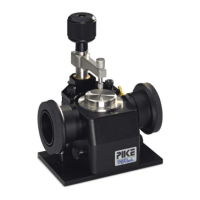PN 350-025004-09
Page | 8
Sampling Procedures
The spectrum of the required sample is obtained by ratioing a scan with a sample in place to a scan with
no sample on the face of the crystal. The crystal mount is located on the base unit. The MIRacle ATR can
be used for all types of samples (liquids, pastes, soft pliable films, powders and solids).
Configuration for Liquid Sampling
The crystal plate assembly of the MIRacle single reflection ATR features a round plate design, with a
1.8 mm sampling area, located in the center (6.0 mm for 3 reflection plates). The sample must be in
intimate contact with the sampling area in order to obtain an FTIR spectrum. For routine sampling, place
a drop of your sample on the ATR crystal and collect data. Care is required when removing the sample
from the crystal. It is desired that the sample be removed without scratching the surface of the crystal.
An optional liquids retainer and volatiles cover are available for quickly evaporating liquid samples. For
volatile liquids, the liquid retainer with volatiles cover reduces the amount of evaporation of the sample
on the surface of the crystal. To use, place the retainer disk over the ATR crystal. Place the U-shaped
bridge over the retainer disk. Apply pressure to the U-shaped bridge using the pressure clamp. Fill the
reservoir of the liquid retainer with the volatile liquid. Slide the volatile cover between the retainer disk
and the U-shaped bridge. Liquids retainer may be used with the high-pressure clamp only.
NOTE: Some crystals used in the accessory are made of fairly brittle materials (such as ZnSe, Si, or Ge).
Scratches on the surface of the crystal will result in a reduction in the throughput of the accessory.
Remove the sample gently with a non-abrasive cotton tissue and rinse with solvent. For more thorough
cleaning, the crystal plate should be cleaned with an appropriate mild solvent such as isopropyl alcohol
or a stronger solvent, such as acetone. Cotton swabs are highly recommended for ease of cleaning
without scratching the soft ATR surface. Sometimes “carry over” may occur from one sample to another
due to incomplete cleaning of a prior sample from the face of the crystal. Samples should not be left in
contact with the crystal for an extended period of time since some samples may degrade the crystal
Liquids Retainer Liquids Retainer with Volatiles Cover

